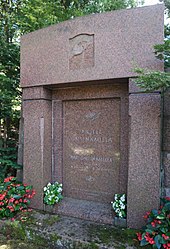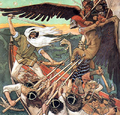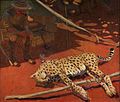Akseli Gallen-Kallela

Akseli Gallen-Kallela (born April 26, 1865 in Pori , Grand Duchy of Finland as Axel Waldemar Gallén ; † March 7, 1931 in Stockholm , Sweden ) was a Finnish painter , architect and designer . He is particularly known for his illustrations for the Finnish national epic Kalevala and is considered the most important representative of Finnish national romanticism in the visual arts .
Life
Youth and family
Gallén came from a well-off Swedish - speaking family. His father was a senior police officer and lawyer . At the age of eleven he was sent to boarding school in Helsinki . In his youth in Helsinki he became interested in the visual arts; so he attended drawing courses at the Finnish Art Society. In 1884 he moved to Paris to study painting at the Académie Julian there. During his student days he made the acquaintance of other Scandinavian artists, including the Finnish painter Albert Edelfelt and the Swedish writer August Strindberg .
After his return to Finland he married Mary Helena Slöör in 1890; the marriage had three children. His wife was his model for a picture of the Madonna (1890) and a triptych on Aino, a figure from Finnish mythology. On his honeymoon through Karelia , he began collecting material for his Kalevala illustrations; especially in East Karelia, beyond the borders of the Russian Grand Duchy of Finland , and in North Karelia, the oral tradition of the old Finnish sagas was as lively as in the time of the writer Elias Lönnrot .
Act
While Gallén's early work was still completely committed to realism , after his return from France the influence of French symbolism and Art Nouveau was formative; at the time it served Finnish patriotism in the face of Russian rule. Since Elias Lönnrot's first Kalevala edition in 1835, this work has been central to the emerging Finnish national romanticism and also provided the composer Jean Sibelius, who was a friend of Gallén, with a variety of motifs. Gallén also devoted himself mostly to motifs from Finnish mythology until his death . In 1907 he officially finished his name as Gallen-Kallela . This is where his residence Kalela at Ruovesi was the inspiration, which he designed and built in the 1890s, also in the style of Finnish national romanticism. His most famous paintings to date were also created in Kalela: The Defense of Sampo (1896), Joukahainen's Revenge , Lemminkäinen's Mother (both 1897) and Kullervo's Curse (1899).
The Aino Triptych (1891)
The Defense of Sampo (1896)
Lemminkäinen's mother (1897)
Kullervo's Curse (1899)
In 1900 he painted for the Finnish pavilion at the Paris World Exhibition frescoes whose political message was clear: In one picture was the legendary Finnish hero Ilmarinen seen plowing a field full of vipers - the snakes were red in the Russian national colors, blue and white held. He reproduced these works in 1928 for the entrance hall of the Finnish National Museum - Finland was now independent.
In 1903 he again created frescoes for the Jusélius mausoleum in Pori. They were destroyed by fire in 1931 and later restored by his son based on his father's sketches. In 1906 he helped the Russian writer Maxim Gorky to escape from the Russian authorities. In 1906, Gallén's illustrations appeared for another central work in Finnish literature, namely for Aleksis Kivi's The Seven Brothers . From March 1907 he was briefly a member of the artists' association Brücke , which he soon left because of incompatible opinions. His works became increasingly known and praised abroad. In 1907 he made a portrait of the composer Gustav Mahler when he was visiting Helsinki. As early as 1895 his works were shown with those of Edvard Munch in Berlin, and in 1914 he represented Finland at the Venice Biennale .
In 1909 he and his family left for British East Africa (now Kenya), where he was to spend two years. During this time around 150 pictures were created, which clearly show the influence of French Expressionism . His experiences in Africa - among other things, he indulged in big game hunting and met the former American President Theodore Roosevelt - he recorded in notebooks, which his son Jorma published as Afrikka-Kirja ("Africa Book") after the death of his father in 1931 . Upon his return, he designed and built a more studio-residence, the castle-like estate Tarvaspää northwest of Helsinki.
After Gallén-Kallela's long-awaited Finnish independence (December 6, 1917), the Finnish civil war broke out and, like the rest of the country, traumatized him for a long time. He was at least symbolically one of the most important heads of the white, i.e. conservative-anti-communist, war party. In 1918 he was raised to the rank of wing adjutant by the Finnish general Mannerheim . Even after the victory of the whites , Gallén-Kallela braced himself in both writings and pictures against the revolution he still feared.
In the 1920s he again devoted himself to new illustrations of the Kalevala. In 1921 the Cubist- influenced Koru-Kalevala ("Jewelry Kalevala") appeared, his Suur-Kalevala ("Greater Kalevala") remained unfinished.
Last years

In 1923 he moved with his family to the USA and in 1924 settled in the Taos artists' colony in New Mexico . Even in the American desert, he mainly worked on pictures of Finnish mythology; One of the exceptions is a portrait of the Indian chief Siu Ohutaa . He did not return to Finland until 1926.
Akseli Gallen-Kallela died in Stockholm in 1931 as a result of pneumonia .
honors and awards
- 2015: On his 150th birthday, the National Bank of Finland issued a 2 euro commemorative coin .
Literature / exhibitions
- Gerd Presler : Akseli Valdemar Gallen-Kallela (1865–1931) in: Gerd Presler: Die Brücke , rowohlt monograph 50642, Reinbek 2007, pp. 31–33, ISBN 978-3-499-50642-0
- Unearthly Nordic , Museum Kunstpalast , Düsseldorf 2012
- From twilight and light - masterpieces of Nordic painting 1860–1920 , Hypo-Kunsthalle , Munich, May 30 to October 6, 2013
Web links
- Works by Akseli Gallen-Kallela at Zeno.org .
- Website of the Gallen Kallela Museum in Finland in English
- Biography and selection of works on kalela.net (English)
Individual evidence
- ↑ Official Journal of the European Union: New national side of the euro coins in circulation (2015 / C 293/03, September 5, 2015) , accessed on July 23, 2016
| personal data | |
|---|---|
| SURNAME | Gallen-Kallela, Akseli |
| ALTERNATIVE NAMES | Gallén, Axél Waldemar |
| BRIEF DESCRIPTION | Finnish painter, architect and designer |
| DATE OF BIRTH | April 26, 1865 |
| PLACE OF BIRTH | Pori , Grand Duchy of Finland |
| DATE OF DEATH | March 7, 1931 |
| Place of death | Stockholm , Sweden |









